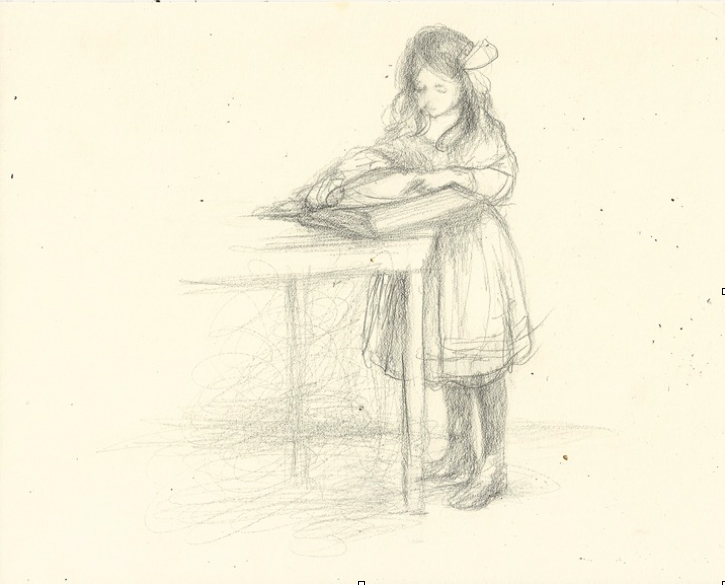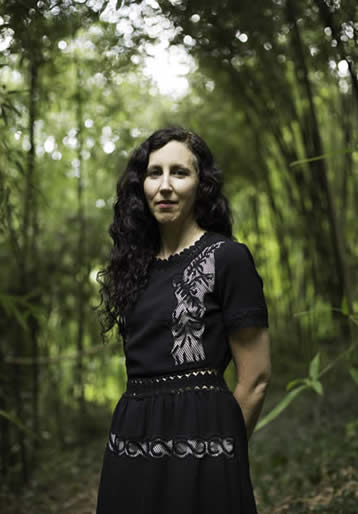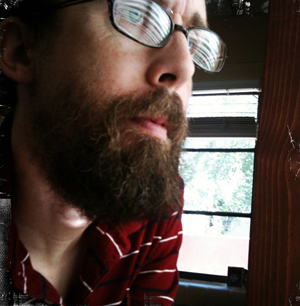Excerpts from Laynie Browne’s novel manuscript, Periodic Companions, a finalist for the 2015 TS Book Prize.

In our actions we are beyond the believable and we divine, through tea leaves or wind, chemical signals, market rates or text codes of our clan— where we are driven next— furthest from before. Join our little gathering despite these many faults and without which we wonder whose art is reverential. Meet our misshapen family. This doesn’t tell us who we are. So we had better get started with our day. We post our whereabouts and disappear like a spectrum walking, stick figures drowned green and dark faded. This image of us, arms linked, ambling away. The body reverts, reinvents.
AG sees us before we arrive and yells happily through handfuls of thyme and pomegranate. We are coming over for dinner, despite the quiet I’d prefer. And yet quiet would now be incomplete, too secret, like the letter “e” left off of particular words such as lit, bit, nil and far.
What about everyone’s occupations- do we now more fully return to them? It shouldn’t matter. Why would anyone want to know? Because, interrupts HG, everyone self identifies with what they do. But that has no place in P’s novel. Especially in that chapter where all of us are X. H says that is how all of the chapters should be written and all of our days spent, all of us remaining X. AG gives her an admiring look, which she does not notice. She continues to say, that if we could do that we wouldn’t need to induce tears.
O is a philosopher and what that means is anyone’s guess, except that he loves to argue. H loves everyone. HG is always changing his mind. A certain amount of patience is required. P is a chemical engineer. I like to draw. None of this belongs. We are going to have a little gathering. You are just entering our patch of concatenations. This little time of ours is sheerly nothing, loosely fitting. S says, P should write it backwards and in pieces and in any way except forward and continuously. Periodically, P looks up from her desk but mostly ignores the banter. The reason anyone creates characters, she says, is for a particular type of company in which we give up upon the idea of control.
I have an indelible image of P in her lemon dress, standing on the edge of the fountain, tears streaming down her face, surrounded on all sides. There was finally, at this moment, no need to cry. But she was gleaming with wet cheeks and she did not attempt to wipe them away. P had rarely been able to summon tears, only fury and revamptive action. She did not cry when AS disappeared and she did not cry over MG’s illness. P did not cry the night she was “It” and I believe she might have been the only one of us to withstand the prodding. All of her blunders were so starkly visible to everyone and yet she was not apologetic. The lemon dress reminds me of the dress of a doll I had as a child. She had delicately painted curls, plastic blue eyes with thick still black lashes. Her eyes did not close when she reclined. The dress was poplin yellow with tiny white dots. She smelled of apple juice and was my constant companion until she was buried in a closet. When I did remember her I dug her out, pulled her dress back down over her head and told her I was sorry. I was devastated by my own capacity for neglect.
The lemon dress was nothing like that actually, so it must have been that I wanted to pull P out of something, smooth her dress, apologize, but for what? For not being able to bring her to tears?
I just want to keep walking with her, as if she exists.
Write the part about trying to remove my tear glands, P urges me. Allergies had convinced me, lifting my eyelid to examine, that the little raised dot was an irritant. It can be easy to forget the essential, wearing an old song as if you could hear anything. When you put something on—— and wear reversible scenarios, dig oneself out of a borrowed closet and ponder ash. P’s voice reverses in memory. Is she sobbing, asking for a referral, longing for the collective? Our tears were for— what were they for?
When S was still initiating— meaning, he did not know us well enough to know certain things, he asked off-putting questions, for instance what would we be crying for- beyond the violence we had observed and the news fragments repeating endlessly within our minds and the clutter of our desks or thoughts. He would stop and pass a hand over his brow as if to wipe something away but he looked exactly the same. He was on board with the experiment of chemical signaling as a way to stem violence but when we asked him to cry he needed prolific reasons. This began an onslaught of collective naming, a montage of statements and symbols we began to collect and read aloud when we wished anyone would cry upon command. This assemblage differed from the initial prompts I had composed in that it was culled collectively. It was perhaps the best performative aspect of our plan and made us remember that some of us wanted to write novels or philosophy and yet we didn’t think that meant to sit alone in a room thinking. We had no problem with thinking alone in rooms but we were rarely alone and we much preferred anywhere else to a room. We placed a box in the public square labeled, “Reasons to Cry.” From these received utterances we began to compile an archive of statements.
P put on her yellow dress, the color of flames, which statistically thus far, made more people cry when she read from the list. Studies show that babies cry more in bright yellow rooms. She was merciless. People were activated and their metabolisms rose before she cried. To reproduce the entire list would be tedious but here is a sampling:
Reasons to Cry (from a collective archive)
She was reduced to hiding under a box. Small, empty furniture. That neighborhood is finished. Tears remove toxins, arrow and quiver. I’ll never see you again. Ceiling tiles are removed so that rain can cascade from the rotting roof into large trash cans underneath. A seven year-old boy was laid to rest. Are you sick of yourself? An earthquake. The new cat is getting all of the attention. Coffin, sarcophagus, cemetery monument. This tragedy could have been prevented. Starting with the most basic function of tears, they enable us to see. She really loved him. 500,000 cases of rape are recorded each year in Cameroon. An archway girded with flowers. 200 Methodist clergy in Illinois defy church on same-sex unions. Ripped clothing. You want to believe and have faith that justice works. Pall, pick, spade, pitcher. Military children left behind. A boy in a lonesome autumn day decided to explore the anatomy of a rabbit. Rod or staff. Americanization tastes great. Crash victim remembered. Kitten shot with air rifle in East Ewell. Ship, sickle, skull, skeleton. Remembering the father who perished in Auschwitz. Vessel with flame. Inconsistent weather. Winged face. A bed that has not had my son to lay his head upon. Weeping at tomb. Nobody did anything. Flood evacuees. The willow tree and the urn. She is just so suppressed and frivolous. What I tell my granddaughter about her mother’s suicide. Resentments gather in the limbic system. Gentrification. She’s not comfortable with human contact. Victims are forced into silence. Cable provider cancelled Lifetime TV. An anchor disguised as a cross. A germaphobic dreams in her sleep. He has to return his MacBook Pro. Slept through the holidays. Dementia patients everywhere. Sacred will I keep thy dear remains.
 ABOUT THE AUTHOR
ABOUT THE AUTHOR
Laynie Browne is the author of twelve collections of poetry and two novels. Her most recent collections of poems include P R A C T I C E (SplitLevel 2015), Scorpyn Odes (Kore Press 2015) and Lost Parkour Ps(alms), in two editions, one in English, and another in French, from Presses universitaires de Rouen et du Havré (2014). Her work appears in The Norton Anthology of Postmodern American Poetry (2013) as well as in Ecopoetry: A Contemporary American Anthology (Trinity University Press, 2013). Her honors include: a 2014 Pew Fellowship, the National Poetry Series Award, the Contemporary Poetry Series Award, and two Gertrude Stein Awards for Innovative American Poetry. She is co-editor of I’ll Drown My Book: Conceptual Writing by Women (Les Figues Press, 2012) and is currently editing an anthology of original essays on the Poet’s Novel. She teaches at University of Pennsylvania and at Swarthmore College.
ABOUT THE ARTIST
 Raised in Mississippi and educated at the Glasgow School of Art in Scotland, Noah Saterstrom currently lives in Nashville, TN with his wife, Julia, and kids, Vivian and Guston. His paintings, drawings, and print installations have been shown most recently in Nashville, TN; Seattle, WA; Brooklyn, NY; New Orleans, LA; Tucson, AZ and Glasgow, Scotland. He has collaborated with writers, including Laynie Browne, Anne Waldman, Kate Bernheimer and is the founder and curator of the on-line quarterly, Trickhouse. Saterstrom’s work is in collections throughout the United States, Scotland, England, South Africa, Australia, Japan and Spain. He is currently represented by the Carol Robinson Gallery (New Orleans, Louisiana) and the Dorpstraat Galery (Stellenbosch, South Africa).
Raised in Mississippi and educated at the Glasgow School of Art in Scotland, Noah Saterstrom currently lives in Nashville, TN with his wife, Julia, and kids, Vivian and Guston. His paintings, drawings, and print installations have been shown most recently in Nashville, TN; Seattle, WA; Brooklyn, NY; New Orleans, LA; Tucson, AZ and Glasgow, Scotland. He has collaborated with writers, including Laynie Browne, Anne Waldman, Kate Bernheimer and is the founder and curator of the on-line quarterly, Trickhouse. Saterstrom’s work is in collections throughout the United States, Scotland, England, South Africa, Australia, Japan and Spain. He is currently represented by the Carol Robinson Gallery (New Orleans, Louisiana) and the Dorpstraat Galery (Stellenbosch, South Africa).
ABOUT THE MANUSCRIPT
Periodic Companions is a novel with characters based on the periodic table of elements. Relationships are based upon chemistry, and characters investigate poetics, contemplative practices, and outsider culture. Overwhelmed with the futility of institutional structures, and impelled to act in response to a tragic act of violence, the elemental characters create a collective action based upon chemical signaling using human tears, in the hopes of inventing a new context for non-violent protest.